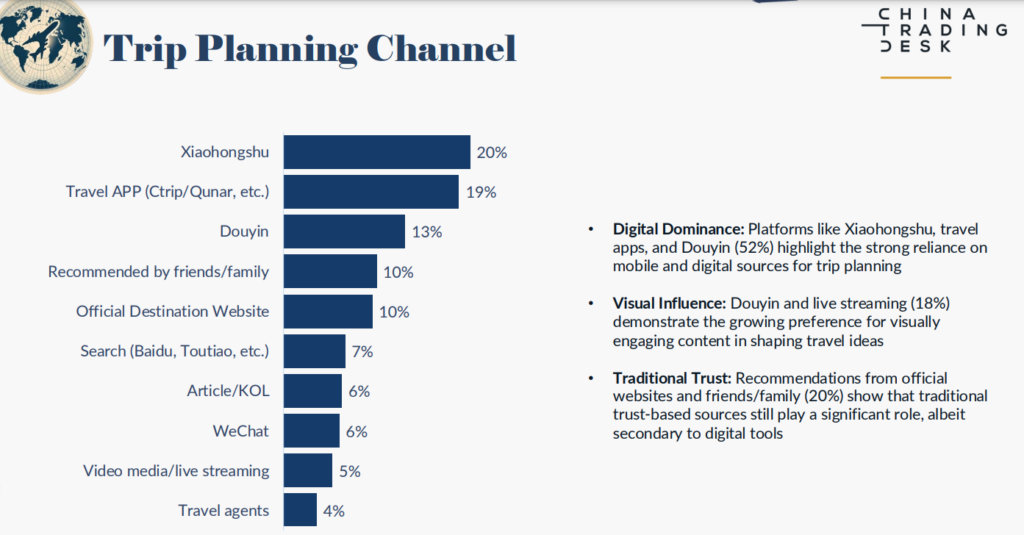China’s outbound travel market remains in recovery mode post-Covid, with an expected 130 million trips in 2024. It’s a big number, but still short of the pre-pandemic peak of 155 million trips. By 2028, the market is projected to surge to 200 million trips, according to a China Trading Desk report releasing on Wednesday, and first reported by Skift.
Economic factors, health and safety concerns, and government travel restrictions continue to influence travel decisions. An earlier Dragon Trail survey had also highlighted that cost of travel has become the primary barrier to selling outbound travel.
And those traveling are reshaping global tourism with evolving preferences, as noted in China Trading Desk’s survey.
Some of the key insights include:
- Regional destinations like Singapore, Japan, and South Korea remain highly favored,.
- Spontaneity has emerged as a defining trend, with 74% of travelers booking trips less than a month in advance.
- Most travelers prioritize booking flights first, while around one-fifth prefer to secure accommodations first.
“Businesses must offer last-minute deals, user-friendly cancellation policies, and dynamic pricing can encourage bookings and boost traveler confidence,” Subramania Bhatt, CEO and founder of China Trading Desk, told Skift.
Gen Z Travel Preferences
Digital platforms such as Xiaohongshu and Douyin are increasingly critical for inspiration with short-form videos and user-generated content playing a major role in shaping travel decisions, especially among the younger demographics.
The 18-29-year-olds have also highlighted that they would be increasing the frequency of their overseas trips with the trip duration going up to almost 10 days.
This trend is part of a broader transformation, as Chinese tourists prioritize immersive, authentic experiences over traditional itineraries. According to the survey, 54% respondents prefer independent travel, especially to destinations which offer affordability alongside rich cultural and leisure activities.
Gen Z travelers show greater interest in outdoor and remote destinations, as well as adventure-oriented travel. Singapore and South Korea are particularly popular, with South Korea’s appeal driven by K-pop culture.
Price is also the main driving factor while deciding on the accommodation, especially for Gen Z travelers.
Bhatt calls this demographic “pivotal,” as it makes up a significant portion of travelers, who display high digital engagement and spend on travel experiences.
The New Chinese Traveler
The profile of the modern Chinese traveler is diverse, and shows a complex and segmented market.
- Spontaneous Gen Z explorers who value unique shareable experiences, who rely heavily on digital platforms and often book last-minute trips.
- Family-oriented frequent travelers who prioritize kid-friendly and multi-generational activities. These travelers prefer well-planned vacations tailored for families, emphasizing comfort and safety.
- Luxury-seeking high-net-worth individuals who demand premium and personalized experiences, often with a culinary and cultural twist.
- Cautious first-time travelers who emphasize safety and affordability. These budget-conscious travelers rely on structured tours and recommendations for their first international ventures.
Targeted marketing strategies must address specific traveler segments, Bhatt said. For instance, spontaneous explorers value last-minute deals and flexible booking options, while cautious first-time travelers need reassurance through value-for-money packages and clear safety measures. “Campaigns that highlight these can resonate strongly with the audience,” he said.
Digital Platforms Influence Travel
As travelers increasingly rely on digital tools for planning, apps like Ctrip and Qunar dominate bookings, while platforms like Xiaohongshu and Douyin influence shopping and itinerary decisions.
“Leveraging digital platforms like Xiaohongshu and Douyin is crucial, as these tools dominate the travel planning process for tech-savvy Chinese travelers. These platforms thrive on peer recommendations and authentic content, making short-form videos, live streams, and user-generated posts essential for engagement. Creating visually appealing, culturally relevant, and authentic content tailored to these spaces can significantly influence traveler decisions,” Bhatt said.

Spending patterns are also evolving, with nearly half of the respondents planning to spend over 25,000 RMB per trip, while the budget of higher-tier travelers exceeds 50,000 RMB. The focus is on accommodations, air tickets, and food. However, shopping for luxury goods abroad remains significant, driven by cost advantages and exclusivity.
Early research and planning for promotions and tax refunds are key for Chinese travelers, with Xiaohongshu emerging as a leading tool for shopping insights.
Digital wallets like Alipay and WeChat Pay are also the preferred payment methods, reflecting China’s cashless society’s influence on global tourism. Among Gen Z travels the reliance on digital payments is higher with only a small percentage using credit cards while traveling internationally.
What Destinations Can Do
While the rebound of China’s outbound travel market signifies a recovery, it also signals a shift in how Chinese consumers engage with the world.
“Destinations and brands must adapt to a tech-savvy and cost-conscious audience,” Bhatt said.
For countries keen to bring in more Chinese travelers, Bhatt suggested, “Create experiences that resonate with Chinese travelers by offering guided tours, cultural activities, and festivals with Mandarin-speaking guides. Provide Mandarin menus, signage, and Chinese-specific dietary options. Align promotional campaigns with major Chinese holidays like Spring Festival and Golden Week, featuring themed packages and discounts.”
He said that while connectivity and direct flight routes from major Chinese cities is helpful to reduce travel time and complexity, a simplified visa process is crucial for tourists.

